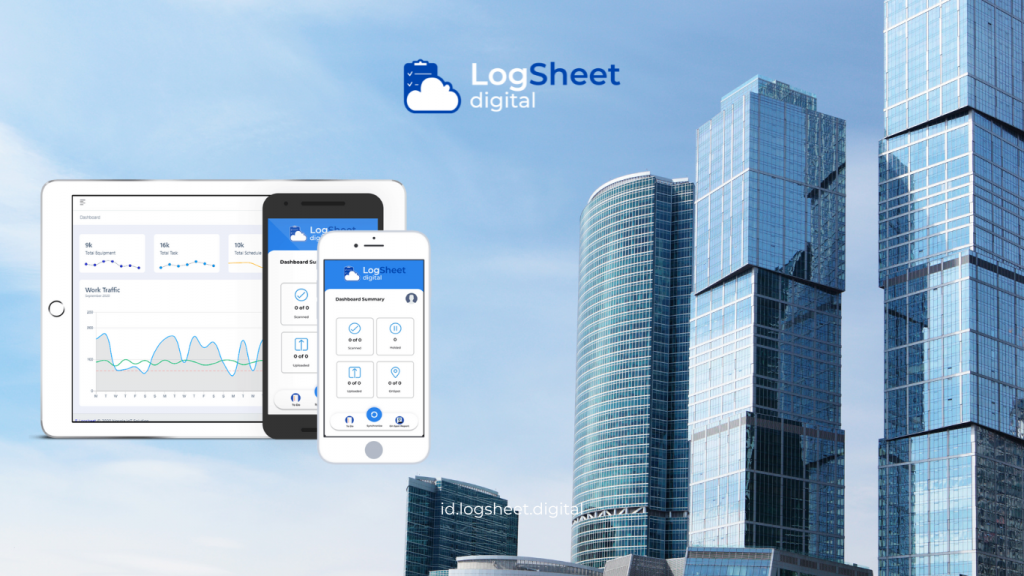Assets are one of the most important elements in the continuity of a company’s operations. Ineffective asset management can trigger various risks, ranging from financial losses to operational disruptions. One modern approach to managing assets more efficiently and safely is by using digital logsheets. This system not only aids in monitoring asset conditions but also in managing potential risks that may arise. This article will discuss the importance of implementing digital logsheets in asset risk management and how it can provide significant benefits for companies.
1. Definition of Digital Logsheet

Read More: Implementation of Digital Logsheet in Asset Security Monitoring
Digital logsheet is a technology-based system that allows for the electronic recording and monitoring of assets. Compared to manual methods, digital logsheet offers ease of data access, more accurate recording, and allows for deeper analysis. The recorded data can include the physical condition of assets, maintenance schedules, and usage history. Thus, digital logsheet provides a comprehensive overview of the status and condition of assets in real-time.
1.1. Advantages of Digital Logsheet
Some of the main advantages of implementing digital logsheet in asset management include:
- Real-Time Data Access: Users can monitor asset conditions anytime and anywhere, as long as they are connected to the internet.
- Data Accuracy: With automated systems, the risk of human error in recording is minimized.
- Ease of Monitoring: Asset monitoring becomes easier as data is neatly organized in a digital format.
1.2. Why Switch from Manual Systems?
Manual systems are prone to human error, take longer, and tend to be less efficient in terms of data storage and retrieval. By using digital logsheet, companies can avoid delays in problem detection and accelerate decision-making to prevent asset damage or performance decline.
2. Asset Risk Management: Challenges and Solutions

Read More: Transformation of the Asset Industry: Advantages of Digital Logsheet in Management
Asset risk management is the process of identifying, analyzing, and addressing potential risks associated with a company’s assets. These risks can include damage, loss, theft, or non-compliance with applicable regulations. The implementation of digital logsheets can help address various challenges in asset risk management by providing accurate and easily accessible data.
2.1. Challenges in Asset Risk Management
Some of the main challenges faced in asset risk management include:
- Lack of Accurate Data: Manual recording systems often result in inaccurate or incomplete data, making it difficult to make sound decisions.
- Difficulty in Asset Tracking: In large companies with numerous assets, manual tracking becomes very complicated and time-consuming.
- Delays in Maintenance: Poorly maintained assets can lead to more severe damage later on.
2.2. Solutions Through Digital Logsheet
With digital logsheet, these challenges can be addressed. Accurate and real-time data allows companies to effectively monitor asset conditions. Additionally, automatic reminders for maintenance schedules ensure that assets are maintained on time, thereby minimizing damage risks.
3. Steps to Implement Digital Logsheet in Asset Risk Management

Read More: Using Digital Logsheet for Asset Condition Reporting
Implementing digital logsheet in asset risk management requires careful planning and the right strategies. Here are the steps that can be followed:
3.1. Identify Assets
The first step is to identify all assets owned by the company. From the most critical assets to supporting assets, all must be recorded and entered into the digital logsheet system. This is crucial to ensure that no assets are overlooked in the monitoring process.
3.2. Assess Asset Risks
After identifying assets, the next step is to assess the risks that may be associated with each asset. These risks can include physical damage, theft, or performance decline. This assessment is essential for prioritizing risk management and determining necessary mitigation steps.
3.3. Integration with Maintenance Systems
For the digital logsheet to function optimally, it is important to integrate it with the company’s maintenance systems. This system can provide early warnings regarding the need for maintenance or repairs of assets, allowing the company to take preventive actions before major problems occur.
3.4. Employee Training
Using digital logsheet requires certain technical skills, especially for employees who were previously accustomed to manual recording. Therefore, employee training is a critical step to ensure the successful implementation of digital logsheet. This training can cover how to input data, read reports, and effectively monitor asset conditions.
3.5. Monitoring and Evaluation
After the digital logsheet system is implemented, companies need to conduct regular monitoring and evaluation to ensure the system operates effectively. This evaluation includes reviewing the data produced by the system and assessing its effectiveness in managing asset risks.
4. Benefits of Implementing Digital Logsheet in Asset Risk Management

Read More: Digital Logsheet as a Key to Smart Assets in Industry 4.0
The implementation of digital logsheet in asset risk management provides numerous benefits for companies, including:
4.1. Reduction of Asset Damage Risks
With a digital logsheet, companies can monitor asset conditions in real-time and perform timely maintenance. As a result, this can reduce the risk of asset damage that may disrupt operations. Moreover, by addressing issues promptly, companies can minimize downtime and enhance overall efficiency. Consequently, this proactive approach helps maintain smooth operations and ensures that assets are utilized effectively.
4.2. Operational Efficiency
Digital logsheet allows companies to monitor assets more quickly and efficiently. Automatically recorded data also simplifies the auditing and reporting process for assets.
4.3. Better Decision-Making
With complete and accurate data, company management can make better decisions regarding asset risk management. For instance, this includes decisions about maintenance, replacement, or sale of assets. Furthermore, having reliable information allows management to assess potential risks more effectively. Consequently, they can prioritize actions that will optimize asset performance and reduce overall costs. Ultimately, this leads to more informed strategies that align with the company’s goals.
4.4. Transparency and Accountability
A digital logsheet provides a complete asset history, from purchase to maintenance and usage. As a result, this creates transparency in asset management and increases accountability among employees responsible for those assets. Moreover, having a detailed record allows for easier tracking of any issues that may arise, therefore facilitating timely interventions. In addition, it fosters a culture of responsibility, which ultimately enhances overall asset performance.
5. Case Studies: Implementation of Digital Logsheet in Industries

Read More: Implementation of Digital Logsheet for Inventory Management and Asset Condition
Several companies across various industries have successfully implemented digital logsheet in their asset risk management. For example, a large manufacturing company in Indonesia successfully reduced machine downtime by 30% after implementing digital logsheet. With this system, the company could monitor machine conditions in real-time and promptly repair any detected issues.
Another company in the energy sector also reported increased maintenance efficiency after switching to digital logsheet. The data produced by this system allowed the company to identify assets that required maintenance early, preventing major damage that could disrupt operations.
Conclusion

Read More: Digital Logsheet: A Revolution in Asset Monitoring in Industry
The implementation of digital logsheet in asset risk management is a strategic step that can help companies manage their assets more effectively and efficiently. With this system, companies can minimize asset damage risks, enhance operational efficiency, and make better decisions based on accurate data. Challenges in asset management, such as difficulties in tracking and maintenance, can be addressed with this digital solution. Thus, digital logsheets not only enhances asset risk management but also provides added value to the overall operations of the company.






leave your comments